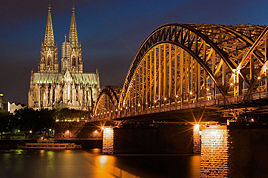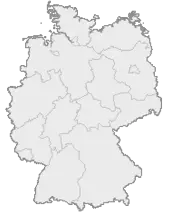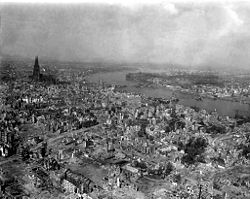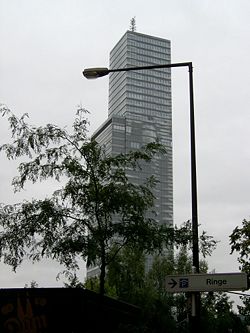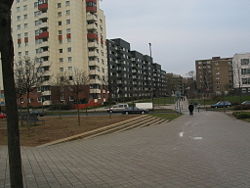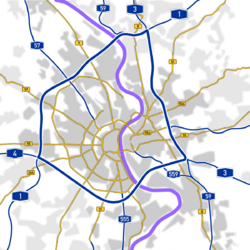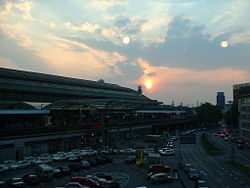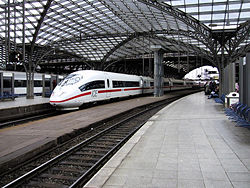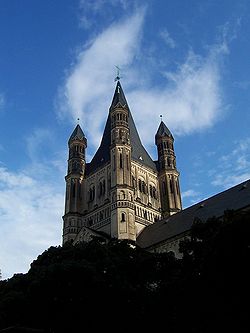Cologne
| Köln Cologne | |
| Cologne Cathedral with Hohenzollern Bridge | |
| Coordinates | |
| Administration | |
| Country | Germany |
|---|---|
| State | North Rhine-Westphalia |
| Admin. region | Cologne |
| District | Urban district |
| Mayor | F. Schramma (CDU) |
| Basic statistics | |
| Area | 405.15 km² (156.43 sq mi) |
| Elevation | 37 m (121 ft) |
| Population | 995,397 (31 December 2007) |
| - Density | 2,457 /km2 (6,363 /sq mi) |
| Founded | 50 |
| Other information | |
| Time zone | CET/CEST (UTC+1/+2) |
| Licence plate | K |
| Postal codes | 50441–51149 |
| Area code | 0221 |
| Website | www.stadt-koeln.de |
Cologne (Template:Audio-de, IPA: [kœln]; local dialect: Kölle [ˈkœɫə]) is Germany's fourth-largest city after Berlin, Hamburg and Munich. It is one of the oldest cities in Germany, having been founded by the Romans in the year 38 B.C.E. Cologne was granted the status of a Roman "city" in the year 50 C.E.
The city's famous Cologne Cathedral (Kölner Dom) is the seat of the Roman Catholic Archbishop of Cologne. The University of Cologne (Universität zu Köln) is one of Europe's oldest universities.
Cologne is a major cultural center of the Rhineland and has a vibrant arts scene. Cologne is home to more than 30 museums and hundreds of galleries. Exhibitions range from local ancient Roman archeological sites to contemporary graphics and sculpture. The city's Trade Fair Grounds are host to a number of trade shows such as the Art Cologne Fair, the International Furniture Fair (IMM) and the Photokina. Cologne is also well-known for its celebration of Cologne Carnival, the annual reggae summerjam, the largest of its kind in Europe, and the LGBT festival Christopher Street Day (CSD).
Geography
Etymology of name – if available.
Cologne is located close to where the River Rhine enters the North German Plain, about 21 miles (34km) northwest of Bonn, 210 feet (65 metres) above sea level.
As part of the North-West German lowlands, and influenced by the Atlantic Ocean, and the North Sea, Cologne has a mild climate. The daily and yearly fluctuations in temperature are subdued, with an average maximum temperature in January of 35°F (1.5°C), rising to an average of around 66°F (19°C) in July. Mean annual precipitation is 28 inches (700mm), spread relatively uniformly throughout the year.
Size – land area, size comparison
As an industrial location, Cologne was liable to high air pollution until well into the 1960s, made worse by increased in road traffic. Biologically, the Rhine was a dead river. Following the desulphurisation of smoke from the power stations, and the introduction of catalytic converters, air pollution has decreased. The introduction of purification plants has cleaned the Rhine and has attracted back many species of fish such as salmon.
Districts
History
Roman Cologne
The first urban settlement on the grounds of what today is the center of Cologne was Oppidum Ubiorum, which was founded in 38 B.C.E. by the Ubii, a Germanic tribe. Cologne became acknowledged as a city by the Romans in 50 C.E. by the name of Colonia Claudia Ara Agrippinensium. Considerable Roman remains can be found in contemporary Cologne, especially near the wharf area, where a notable discovery of a 1900 year old Roman boat was made in late 2007.[1] From 260 to 271 Cologne was the capital of the Gallic Empire under Postumus, Marius and Victorinus. In 310 under Constantine a bridge was built over the Rhine at Cologne.
Maternus, who was elected as bishop in 313 C.E., was the first known bishop of Cologne. The city was the capital of a Roman province until occupied by the Franks in 459 C.E. In 785A D, Cologne became the seat of an archbishopric.
Middle Ages
During the time of the Holy Roman Empire in the Middle Ages, the Archbishop of Cologne was one of the seven prince-electors and one of the three ecclesiastical electors. The archbishops had ruled large temporal domains but in 1288 Sigfried II von Westerburg was defeated in the Battle of Worringen and forced into exile at Bonn.
Cologne's location on the river Rhine placed it at the intersection of the major trade routes between east and west and was the basis of Cologne's growth. Cologne was a member of the Hanseatic League and became a Free Imperial City in 1475. Interestingly the archbishop nevertheless preserved the right of capital punishment. Thus, the municipal council (though in strict political opposition towards the archbishop) depended upon him in all matters concerning criminal jurisdiction. This included torture, which sentence was only allowed to be handed down by the episcopal judge, the so-called "Greve". This legal situation lasted until the French conquest of Cologne.
Besides its economic and political significance Cologne also became an outstanding centre of medieval pilgrimage, when Cologne's Archbishop Rainald of Dassel gave the relics of the Three Wise Men to Cologne's cathedral in 1164 (after they in fact had been captured from Milan). Besides the three magi Cologne preserves the relics of Saint Ursula and Albertus Magnus.
The economic structures of medieval and early modern Cologne were characterized by the city's status as a major harbor and transport hub upon the Rhine. Craftsmanship was organized by self-administrating guilds, some of which were exclusive to women.
As a free city Cologne was a sovereign state within the Holy Roman Empire and as such had the right (and obligation) of maintaining its own military force. Wearing a red uniform these troops were known as the Rote Funken (red sparks). These soldiers were part of the Army of the Holy Roman Empire ("Reichskontingent") and fought in the wars of the 17th and 18th century, including the wars against revolutionary France, when the small force almost completely perished in combat. The tradition of these troops is preserved as a military persiflage by Cologne's most outstanding carnival society, the Rote Funken[2].
The free city of Cologne must not be confused with the Archbishopric of Cologne which was a state of its own within the Holy Roman Empire. Since the second half of the 16th century the archbishops were taken from the Bavarian dynasty Wittelsbach. Due to the free status of Cologne, the archbishops usually were not allowed to enter the city. Thus they took residence in Bonn and later in Brühl on Rhine. As members of an influential and powerful family and supported by their outstanding status as electors, the archbishops of Cologne repeatedly challenged and threatened the free status of Cologne during the 17th and 18th century, resulting in complicated affairs, which were handled by diplomatic means and propaganda as well as by the supreme courts of the Holy Roman Empire.
19th and 20th century
Cologne lost its status as a free city during the French period. According to the Peace Treaty of Lunéville (1801) all the territories of the Holy Roman Empire on the left bank of the Rhine were officially incorporated into the French Republic (which already had occupied Cologne in 1798). Thus, this region later became part of Napoleon's Empire. Cologne was part of the French Département Roer (named after the River Roer, German: Rur) with Aachen (Aix-la-Chapelle) as its capital. The French modernized public life by introducing the Code Napoleon as civil code and removing the old elites from power, to cite two examples. The Code Napoleon was in use in the German territories on the left bank of the Rhine until the year 1900, when for the first time the German Empire passed a nationwide unique civil code ("Bürgerliches Gesetzbuch"). In 1815, at the Congress of Vienna, Cologne was made part of the Kingdom of Prussia, administered successively in the Province of Jülich-Cleves-Berg and the Rhine Province.
The permanent tensions between the Roman Catholic Rhineland and the overwhelmingly Protestant Prussian state repeatedly escalated with Cologne being in the focus of the conflict. In 1837 the archbishop of Cologne Clemens August von Droste-Vischering was arrested and imprisoned for two years after a dispute over the legal status of marriages between Protestants and Roman Catholics ("Mischehenstreit"). In 1874 during the Kulturkampf archbishop cardinal Paul Melchers was arrested and imprisoned. He fled to the Netherlands and was searched for like an ordinary criminal by a warrant of apprehension. These conflicts alienated the Catholic population from Berlin and contributed to a deeply felt anti-Prussian resentment, which was still significant after World War II, when the former mayor of Cologne, Konrad Adenauer, became the first West German chancellor.
During the nineteenth and twentieth centuries, Cologne incorporated numerous surrounding towns, and by the time of World War I had already grown to 700,000 inhabitants. Industrialization changed the city and spurred its growth. Especially booming branches were vehicle construction and engine building. Heavy industry was less ubiquitous as opposed to the Ruhr Area. The cathedral, started in 1248 but abandoned around 1560, was eventually finished in 1880 not only as a religious building but also as a German national monument celebrating the newly founded German empire as well as the continuity of the German nation since the Middle Ages. Sometimes urban growth happened very much at the expense of the city's historic heritage with many buildings being broken down (e.g. the city walls or the surroundings of the cathedral) or replaced by contemporary constructions. On the other side Cologne was turned into a heavily armed fortress (opposing the French and Belgian fortresses of Verdun and Liège) with two fortified belts surrounding the city, the relics of which can be seen until today. The military demands of what finally turned out to be Germany's largest fortress meant a huge obstacle to urban development, as forts, bunkers and dugouts with a vast and plain shooting field before them completely encircled the city and prevented any expansion beyond the fortified line, resulting in a very dense built-up area within the city itself.
After WWI, during which several minor air raids had targeted the city, Cologne was occupied by British Forces under the terms of the armistice and the subsequent Versailles Peace Treaty. The occupation lasted until 1926.[3] In contrast to the harsh measures of French occupation troops in the Rhineland the British acted much more tactfully toward the local population. The mayor of Cologne (the future West German chancellor) Konrad Adenauer paid them respect for their political significance, as the British withstood the French ambitions for a permanent Allied occupation of the Rhineland. In 1919 the University of Cologne (which had been closed by the French in 1798) was refounded. It was meant as a substitute for the German University of Strasbourg which had become French in 1918/19. The era of the Weimar Republic (1919–1933) rendered very prolific for Cologne. Many improvements were made under the guidance of Mayor Konrad Adenauer, especially as far as public governance, housing, planning and social affairs are concerned. Large public parks were created, in particular the two "Grüngürtel" (green belts), which were planned on the areas of the former fortifications. They had been dismantled according to the de-militarization of the Rhineland under the terms of the peace treaty, albeit this project was unfinished until 1933. Public housing was executed in a way that it became exemplary all over Germany. As Cologne competed for hosting the Olympics a modern stadium was erected in Müngersdorf. By the end of the British occupation German civil aviation was readmitted over Cologne and the airport of Butzweilerhof soon became an outstanding hub of national and international air traffic, second in Germany only to Berlin-Tempelhof. By 1939 the population had risen to 772,221. Compared to other major cities the Nazis did not gain decisive support in Cologne and the votes cast for the NSDAP at the election for the Reichstag always accounted below the average result of the Reich.[4]
World War II
During World War II, Köln was a Military Area Command Headquarters (Militärische Bereich Befehl Hauptsitze) for Military District (Wehrkreis) VI in Münster. Cologne was under the command of Lieutenant-General Freiherr Roeder von Diersburg, who was responsible for military operations at Bonn, Siegburg, Aachen, Jülich, Düren, and Monschau. Cologne was the Home Station for the 211th Infantry Regiment and the 26th Artillery Regiment.
In World War II, Cologne endured exactly 262 air raids by the Western Allies, which caused approximately 20,000 civilian casualties and completely wiped out the center of the city. During the night of 31 May 1942, Cologne was the site of "Operation Millennium", the first 1,000 bomber raid by the Royal Air Force in World War II. 1,046 heavy bombers attacked their target with 1,455 tons of explosive. This raid lasted about 75 minutes, destroyed 600 acres (243 ha) of built-up area, killed 486 civilians and made 59,000 people homeless. By the end of the war, the population of Cologne was reduced by 95%. This loss was mainly caused by a massive evacuation of the people to more rural areas. The same happened in many other German cities in the last two years of war. At the end of 1945, the population had already risen to about 500,000 again.
By that time, essentially all of Cologne's pre-war Jewish population of 20,000 had been displaced. The synagogue, originally built between 1895 and 1899 by architects Wilhelm Schreiterer and Bernhard Below, was severely damaged during the pogrom of 9 November 1938 (Kristallnacht) but ultimately destroyed by Allied bombing between 1943 and 1945. It was reconstructed in the 1950s. The Cologne synagogue was the stage of a historic event in 2005, when the German-born pope Benedict XVI was the second pope ever to visit a synagogue.
Post-war Cologne
Despite Cologne's status of being the largest city in the region, nearby Düsseldorf was chosen as the political capital of the Federal State North Rhine-Westphalia. With Bonn being chosen as the provisional capital (provisorische Bundeshauptstadt) and seat of the government of the Federal Republic of Germany, Cologne benefited by being sandwiched between the two important political centers of former West Germany. The city became home to a large number of Federal agencies and organizations. After re-unification in 1990 Berlin was made the Federal capital of Germany.
For Cologne mayors refer to: List of mayors of Cologne.
In 1945 architect and urban planner Rudolf Schwarz called Cologne the "world's greatest heap of debris". Schwarz designed the master plan of reconstruction in 1947, which called for the construction of several new thoroughfares thru the downtown area, especially the Nord-Süd-Fahrt ("North-South-Drive"). The masterplan took into consideration the fact that even shortly after the war a large increase in automobile traffic could be anticipated. Plans for new roads had already to a certain degree evolved under the Nazi administration, but the actual construction became easier in times when the majority of downtown lots were undeveloped. The destruction of famous Romanesque churches like St. Gereon, Great St. Martin, St. Maria im Capitol and about a dozen others in World War II meant a tremendous loss of cultural substance to the city. The rebuilding of those churches and other landmarks like the Gürzenich event hall was not undisputed among leading architects and art historians at that time, but in most cases, civil intention prevailed. The reconstruction lasted until the 1990s, when Romanesque church of St. Kunibert was finished.
It took some time to rebuild the city. In 1959 the city's population reached pre-war numbers again. Afterwards the city grew steadily, and, in 1975, the number exceeded 1 million inhabitants for about one year. Since then, the number lingers slightly underneath.
In the 1980s and 1990s Cologne's economy prospered from two factors: First, the steady growth in the number of media companies, pertaining to both the private and the public sector. Catering especially to these companies is the newly developed Media Park, which creates a strongly visual focal point in downtown Cologne and includes the KölnTurm, one of Cologne's most prominent high-rises. And second, a permanent improvement of the diverse traffic infrastructure, which makes Cologne one of the most easily accessible metropolitan areas in Central Europe.
Due to the economic success of the Cologne Trade Fair, the city arranged a large extension to the fair site in 2005. At the same time the original buildings, which date back to the 1920s are rented out to RTL, Germany's largest private broadcaster, as their new corporate headquarters.
Government
Cologne is incorporated under the Gemeindeordnung Nordrhein-Westfalen (GO NRW) (Municipality Code of North Rhine-Westphalia). The city's administration is headed by a mayor (Oberbürgermeister) and three deputy mayors. Cologne was the first city in Germany with a tax specifically for prostitution (see prostitution in Germany).
Coat of arms
The three crowns symbolize the Magi (Three Wise Men) whose bones are said to be kept in a golden sarcophagus in Cologne Cathedral (see Shrine of the Three Kings at Cologne Cathedral). In 1164, Rainald of Dassel, the archbishop of Cologne, brought the relics to the city, making it a major pilgrimage destination. This led to the design of the current cathedral as the predecessor was considered too small to accommodate the pilgrims.
The eleven tears are a reminder of Cologne's patron, Saint Ursula, a Britannic princess, and her legendary 11,000 virgin companions who were supposedly martyred by Attila the Hun at Cologne for their Christian faith in 383. The entourage of Ursula and the number of victims was significantly smaller; according to one source, the original legend referred to only eleven companions and the number was later inflated by relic traders.[5])
Economy
Overview – Any specialization: For instance, is a manufactured product is associated with particular cities a. Milwaukee—cheese and beer b. Los Angeles—entertainment industry c. Sheffield—coal d. top 20 cities in the U.S. are highly specialized
Per capita GDP, rank Financial and business services sector Tourism Manufacturing Within Germany, Cologne is known as an important media center. Several radio and television stations, including Westdeutscher Rundfunk (WDR), RTL and VOX (TV channel), are based in the city.
Transport: Road, rail, air, sea
Roads
Road building had been a major issue in the 1920s under the leadership of mayor Konrad Adenauer. The first German limited access road was constructed after 1929 between Cologne and Bonn. Today, this is A 555. In 1965 Cologne became the first German city to be fully encircled by a freeway belt. Roughly at the same time a downtown bypass freeway (Stadtautobahn) was planned, but only partially executed, due to opposition by environmental groups. The completed section became Bundesstraße ("Federal Road") B 55a which begins at the Zoobrücke ("Zoo Bridge") and meets with A 4 and A 3 at the interchange Cologne East. Nevertheless, it is referred to as Stadtautobahn by most locals. Fully accomplished in contrast was the Nord-Süd-Fahrt ("North-South-Drive"), a new four/six lane downtown thoroughfare, which had already been anticipated by planners like Fritz Schumacher in the 1920s. The last section south of Ebertplatz was completed in 1972.
In 2005 the first stretch of an eight-lane freeway in North Rhine-Westphalia was opened to traffic on Bundesautobahn 3, part of the eastern section of the freeway belt between the interchanges Cologne East and Heumar.
Public transport
Cologne has Deutsche Bahn Service with Intercity and ICE-trains stopping at Köln Hauptbahnhof (Cologne Central Station), Köln-Deutz station and at Cologne Bonn Airport (Konrad-Adenauer-Flughafen). ICE and Thalys high-speed trains link Cologne with Brussels and Paris. There are frequent ICE trains to other German cities, including Frankfurt am Main and Berlin.
The Cologne subway (Kölner-Verkehrs-Betriebe AG) operates an extensive light rail system (partially underground) serving Cologne and some neighboring cities, referred to as the S-Bahn, and U-Bahn. Nearby Bonn is linked by the S-Bahn as well as Deutsche Bahn trains, and occasional recreational boats on the Rhine.
There also are frequent buses covering most of the city and surrounding suburbs, and Eurolines coaches to London via Brussels.
The Rheinseilbahn - an aerial tramway crossing the Rhine.
Cycling
Like most German cities, Cologne has a traffic layout designed to be bicycle-friendly. There is an extensive cycle network, featuring pavement-edge cycle lanes linked by cycle priority crossings. In many of the small city center streets with one-way restrictions, cyclists are explicitly allowed to cycle both ways.
Air transport
Cologne's international airport is Cologne Bonn Airport (CGN). It is also called Konrad Adenauer Airport after Germany's post-war Chancellor, Konrad Adenauer, who was born in Cologne and was mayor of the city from 1917 until 1933. The airport is shared with the neighboring city of Bonn. Most destinations are located in Europe, however, there are two proper intercontinental services: a daily flight to Newark Liberty Airport (EWR) and Iran Air flights to Tehran's Mehrabad International Airport 4 times a week. More intercontinental flights are offered at nearby Düsseldorf International Airport (DUS).
Demographics
Cologne is the fourth-largest city in Germany in terms of inhabitants after Berlin, Hamburg and Munich. Officially, the city still had somewhat fewer than a million inhabitants as of December 2006, with 989,766 people. [6]). Cologne is the center of an urban area of around two million inhabitants (including the neighboring cities of Bonn, Hürth, Leverkusen, and Bergisch-Gladbach.
The population density was 2528 inhabitants per square kilometer. About 31.4 percent of the population had migrated there, and 17.2 percent of Cologne's population was non-German. The largest group, comprising 6.3 percent of the total population, was Turkish[7]. As of September 2007, there were about 120,000 Muslims living in Cologne, mostly of Turkish origin [8].
German is Germany's only official and most-widely spoken language. English is the most common foreign language and almost universally taught by the secondary level.
Christianity is the largest religion in Germany with 53 million adherents. The second largest religion is Islam with 3.3 million adherents (4 percent) followed by Buddhism and Judaism, both with around 200,000 adherents (ca. 0.25 percent). Hinduism has some 90,000 adherents (0.1 percent). The third largest religious identity in Germany is that of non-religious people (including atheists and agnostics (especially in former GDR)), who amount to a total of 28.5 percent of the population.
The Cologne University, with approximately 44,000 students in 2005, was the largest university in Germany.
Culture
Cologne is well-known for its beer, called Kölsch. Kölsch is also the name of the local dialect. This has led to the common joke that Kölsch is the only language you can drink.
Cologne is also famous for Eau de Cologne (Kölnisch Wasser). At the beginning of the 18th century, Italian expatriate Johann Maria Farina (1685–1766) created a new fragrance and named it after his hometown Cologne, Eau de Cologne (Water of Cologne). In the course of the 18th century the fragrance became increasingly popular. Eventually, Cologne merchant Wilhelm Mülhens secured the name Farina, which at that time had become a household name for Eau de Cologne, under contract and opened a small factory at Cologne's Glockengasse. In later years, and under pressure from court battles, his grandson Ferdinand Mülhens chose a new name for the firm and their product. It was the house number that was given to the factory at Glockengasse during French occupation of the Rhineland in the early 19th century, number 4711. In 1994, the Mülhens family sold their company to German Wella corporation. In 2003 Procter & Gamble took over Wella. Today, original Eau de Cologne still is produced in Cologne by both the Farina family (Farina gegenüber since 1709), currently in the eighth generation, and by Mäurer and Wirtz who bought the 4711 brand in December 2006.
Carnival
Cologne carnival is one of the biggest street festivals in Europe. It is held annually; the season starts officially on 11 November at 11 minutes after 11 with the proclamation of the new Carnival Season, and it continues until Ash Wednesday. But the so-called "Tolle Tage" (mad days) don't start until Weiberfastnacht (Women's Carnival) or, in dialect, Wieverfastelovend (Thursday before Ash Wednesday), which is the beginning of the street carnival. Hundreds of thousands of visitors flock to Cologne during this time. Generally around a million people are celebrating in the streets on the Thursday before Ash Wednesday.[9]
Landmarks
The center of Cologne was completely destroyed during World War II. The reconstruction of the city followed the style of the 1950s, while respecting the old layout and naming of the streets. Thus, the city today is characterized by simple and modest post-war buildings, with few interspersed pre-war buildings which were reconstructed due to their historical importance. Some buildings of the "Wiederaufbauzeit" (era of reconstruction), for example the opera house by Wilhelm Riphahn, are nowadays regarded as classics in modern architecture. Nevertheless, the uncompromising style of the opera house and other modern buildings has remained controversial.
- Cologne Cathedral (German: Kölner Dom) is the city's famous landmark and unofficial symbol. It is a Gothic church, started in 1248, and completed in 1880. In 1996, it was designated a World Heritage site; it claims to house the relics of the Three Magi.[citation needed] It is interesting to note that the residents of Cologne call the cathedral "the eternal construction site" (Dauerbaustelle). They predict that, by the time the renovation of the building has finished, the end of the world will be upon us!
- Twelve Romanesque Churches: These buildings are outstanding examples of medieval sacral architecture. The roots of some of the churches date back as far as Roman times, like St. Gereon, which originally was a chapel on a Roman graveyard. With the exception of St. Maria Lyskirchen all of these churches were very badly damaged during World War II. Reconstruction was only finished in the 1990s.
- Fragrance Museum Farina House, the birthplace of Eau de Cologne.
- Römisch-Germanisches Museum (English: Roman-Germanic Museum) for ancient Roman and Germanic culture.
- Wallraf-Richartz Museum for medieval art.
- Museum Ludwig for modern art.
- EL-DE Haus, the former local headquarters of the Gestapo houses a museum documenting the Nazi rule in Cologne with a special focus on the persecution of political dissenters and minorities.
- Lanxess Arena (formerly known as Kölnarena), a multifunctional event hall, home to the local hockey team, the Kölner Haie (English: Cologne Sharks).
- Kölnturm (English: Cologne Tower), Cologne's second tallest building at 165.48 meters (542.91 ft) in height, second only to the Colonius (266 m/873 ft).
- Colonius - a telecommunication tower with an observation deck (closed since 1992).
- Colonia Hochhaus - Germany's tallest residential building.
- Köln Triangle Tower - opposite the cathedral with a 103 m (338 ft) high viewing platform - in contrast to the cathedral with an elevator and a view with the cathedral over the Rhine.
- Hansa Hochhaus - designed by architect Jakob Koerfer and completed in 1925, it was at one time Europe's tallest office building.
- Messeturm Köln (English: Exhibition Tower Cologne).
- Hohe Strasse (English: High Street) is one of the main shopping areas and extends past the cathedral in an approximately southerly direction. This street is particularly popular with tourists and contains many gift shops, clothing stores, fast food restaurants and electronic goods dealers.
- Ford Motor Company plants, assembling the Ford Fiesta and Ford Fusion as well as manufacturing engines and parts; headquarters for Ford of Europe.
- The Panasonic Toyota Racing Formula One team has its factory in the city.
- Schildergasse - extends the shopping area of Hohe Strasse to the west ending at Neumarkt.
- Ehrenstrasse - the shopping area around Apostelnstrasse, Ehrenstrasse, and Rudolfplatz is a little more on the eccentric and stylish side.
- Historic Ringe boulevards (such as Hohenzollernring, Kaiser-Wilhelm-Ring, Hansaring) with their medieval city gates (such as Hahnentorburg on Rudolfplatz) are also known for their night life.
- The city also hosts the Cologne Comedy Festival, which is considered to be the largest comedy festival in mainland Europe.
Sport
The city is host to the soccer team 1. FC Köln who compete in the Bundesliga and American football team Cologne Centurions who played in the now defunct NFL Europa. These two teams both play out of the RheinEnergieStadion, one of the stadiums used during the 2006 FIFA World Cup. The city is also home of the hockey team Kölner Haie (Cologne Sharks), of the DEL, the highest hockey league in Germany. Their home arena is the Kölnarena (Cologne Arena). Furthermore Cologne is home of the basketball team Köln 99ers of the Basketball Bundesliga(BBL). Since 1997 the city has hosted the annual Cologne Marathon.
ReferencesISBN links support NWE through referral fees
- ↑ C.Michael Hogan, Cologne Wharf, The Megalithic Portal, editor Andy Burnham, 2007
- ↑ Rote Funken - Kölsche Funke rut-wieß vun 1823 e.V. - Rote Funken Koeln
- ↑ Cologne Evacuated, TIME Magazine, February 15, 1926
- ↑ Weimarer Wahlen
- ↑ WM-Stadt Köln: Glaube, Lüge, Hoffnung - Reise - SPIEGEL ONLINE - Nachrichten
- ↑ Bevölkerung im Regierungsbezirk Köln
- ↑ 2007 - Einwohnerdaten im Überblick - Zahlen + Statistik - Bevölkerung - Stadt Köln
- ↑ WDR Article of 15.08.2007
- ↑ Carnival - Cologne`s “fifth season” - Cologne Sights & Events - Stadt Köln
External links
Official information
- Cologne: Profile Retrieved August 27, 2008.
- City of Cologne, official City of Cologne page
- Cologne, Cologne information portal
- Kölner Dom, Cologne Cathedral's official website
Tourism and travel
- Cologne Tourist Board
- Cologne Traffic Information
- Cologne Airport
- KVB - Cologne Public Transport
- Eau de Cologne Museum
- 20th World Youth Day 2005
- Official Cologne City Map with Buses, Subways and Trains
- Cologne Zoo at Zoo-Infos.de (in English)
- Dom WebCam
- Travel guide to Cologne from Wikitravel
- 250 pictures with guide of Cologne's places of interest
- Site with photos from Cologne
Culture and history
- Academy for the Language of Cologne
- Rote Funken
- The Prussian fortress Cologne
- Soundmap of Cologne
- Livius.org: Colonia Claudia Ara Agrippinensium (Köln)
- German Sports & Olympic Museum, with exhibitions about sports from antiquity until the present.
- Schokoladenmuseum (Chocolatemuseum) officially called Imhoff-Schokoladen-Museum.
- JavaMuseum - Forum for Internet Technology in Contemporary Art - collections of Internet based art, corporate part of (NewMediaArtProjectNetwork):cologne - the experimental platform for art and New Media.
Credits
New World Encyclopedia writers and editors rewrote and completed the Wikipedia article in accordance with New World Encyclopedia standards. This article abides by terms of the Creative Commons CC-by-sa 3.0 License (CC-by-sa), which may be used and disseminated with proper attribution. Credit is due under the terms of this license that can reference both the New World Encyclopedia contributors and the selfless volunteer contributors of the Wikimedia Foundation. To cite this article click here for a list of acceptable citing formats.The history of earlier contributions by wikipedians is accessible to researchers here:
The history of this article since it was imported to New World Encyclopedia:
Note: Some restrictions may apply to use of individual images which are separately licensed.
